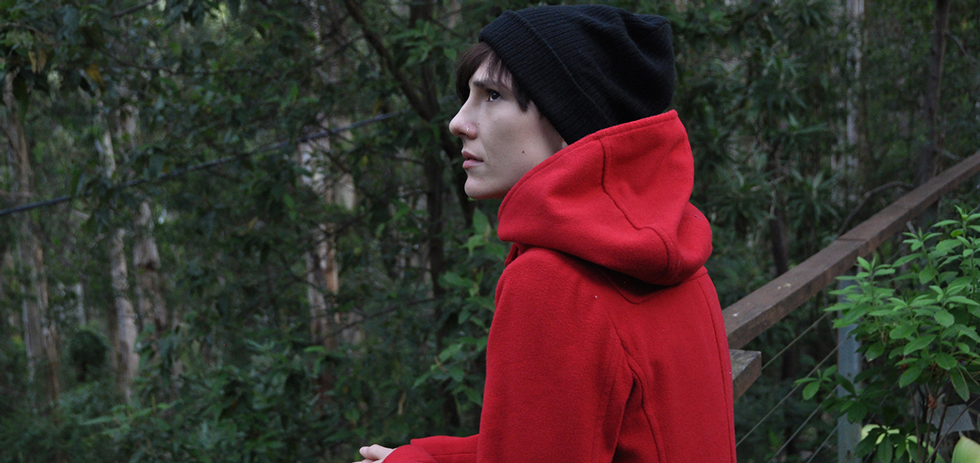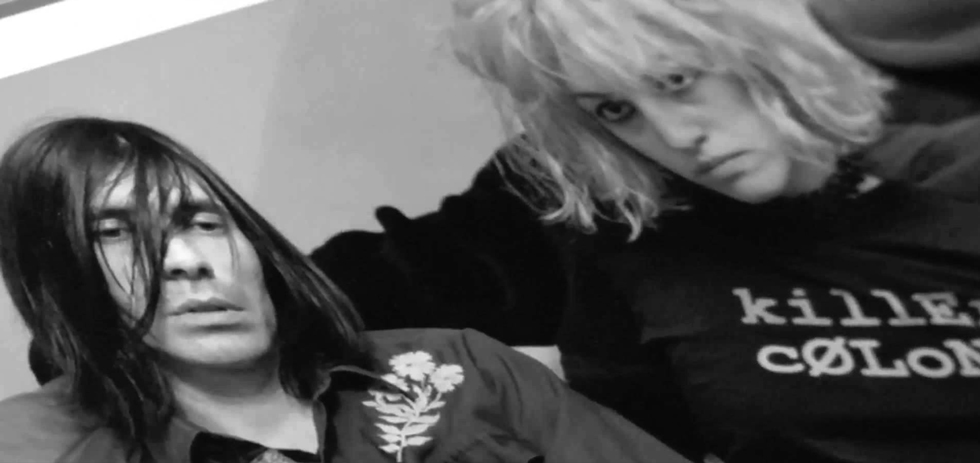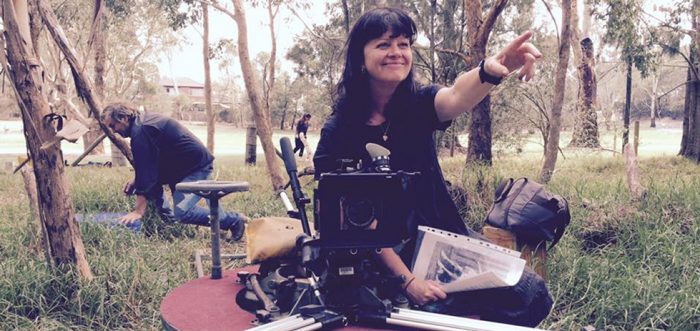In recent years, Australian filmmaker Donna McRae has been determinedly creating some of the most thoughtful and powerful genre films in the country. While opting for clear horror frameworks, McRae uses the genre as a toolbox with which to build her own stories about women haunted – literally and metaphorically – by traumas related to troubled men in their past.
McRae’s 2012 feature debut Johnny Ghost was a micro-budget film set in Melbourne’s vibrant post-punk scene that traces a woman coming to terms with her past through a tattoo removal. It received international acclaim and won a number of awards, including a Best Director award at the Berlin Independent Film Festival. McRae has just released her follow-up feature, Lost Gully Road. Tracing a young woman hiding from a social media-related drama in Melbourne’s beautiful Dandenong Ranges, the film uses horror as a metaphoric template with which to think through the ubiquity of violence against women in contemporary Australia.
McRae’s first documentary Cobby: The Dark Side of Cute also recently played the San Francisco Documentary Film Festival, and she is continuing to develop with producer Tait Brady her feature Kate Kelly – a feature-length Western about Ned Kelly’s sister – which was selected for Montreal’s Frontieres Co-Production Market in 2016.
Lost Gully Road is playing mid-July at Revelation Perth International Film Festival, followed by a Q+A and screening at Melbourne’s Cinema Nova with McRae, producer Liz Baulch and composers Clare Moore and Dave Graney on 24 July.
When was the first moment you remember being fascinated with horror?
As a child watching Casper the Friendly Ghost! I loved the imagery of the haunted house, the trio of spooky ghosts (who can forget them lining up with chains laughing as they taught Casper to ‘spook’?), and the fact that they could all fly! A few years later Deadly Earnest (on TV on Friday nights in Adelaide) introduced me to Val Lewton and the wonderful black and white horror films of the 1940s and 50s.
I know you are also a documentary filmmaker, but your two feature films are particularly fascinating to me because, although being quite different in style, tone, and setting, they both use a horror framework to talk about very real issues of women and trauma. What do you think the particular strength of horror is in addressing these elements?
The particular strength of horror is that you can examine a social issue but wrap it up in a palatable way to audiences using genre. If I presented Lucy’s story [in Lost Gully Road] in social realism it would be very hard to watch. However, using genre tropes I can look at her plight but heighten the experience for the audience.
Women have always been a mainstay of horror but have so often been victims of violence through a male gaze. With Lost Gully Road I have told the story very much through a female viewpoint. The violence is there, but we are experiencing it through Lucy, instead of looking at her. Her character is clearly flawed, but in the end we are on her side, and we can see what hideous violence can do to a vulnerable woman by herself with no one to help her.
Johnny Ghost is not just a great story about a woman struggling with her past, it also feels like a little window back in time to post-punk Melbourne. What’s your experience with that scene? There’s great live footage in there of some very familiar bands – how did that come about to being incorporated?
When I moved over to Melbourne in the post-punk years I was plunged into the scene of the Seaview Ballroom (my first bar job). I was both fascinated and overwhelmed by this artistic, indulgent and dangerous scene which didn’t last very long but produced some very interesting artists, musicians and filmmakers. Those involved moved past that scene but in the last few years it seems to have become iconified by a new generation.
I felt that I needed to include the music of the time in the film for authenticity. Dave Graney and Clare Moore had first hand knowledge and were the obvious choice to score. Mick Harvey and Nick Cave very generously allowed the Birthday Party clip. Even though the story is fictitious it resonates truthfully with those who lived through it – for better or for worse. The film had more interest overseas than here but is available on Ozflix for anyone who would like to see it. I’m very proud of it.

Lost Gully Road reimagines the ‘rapist ghost’ premise of The Entity in a specifically Australian context to talk about the widespread, ‘faceless’ ubiquity of the presence of sexual violence in the lives of Australian women. I’m interested to hear from you if people have been able to draw on that subtext easily, or if it’s being read as a more straight-forward ghost story. Have any responses to the film surprised you?
Revelation Film Festival in Perth will be its second screening after Monsterfest, and then we will have the Melbourne Nova screening on July 24th, so it’s just beginning to play now. Audiences at Monsterfest were drawn to the comparisons with some of the recent horrific stories of domestic and random violence toward women and quite surprised by the nastiness at the end of the film. They said it was very beautiful too, so it’s hard to judge.
It’s a slow burn film – so you need to stay with it until the pay-off at the end. It’s also quite dark (literally dark – she is in a dark, damp house in the Dandenong Ranges) which adds to the dread. I was sitting next to someone at the Monsterfest screening and they were on the edge of their seat. People were also screaming in parts, which is always good – they then laugh at their own reaction, which is fun.
However, the film is a comment on violence towards women and the enablers that help it to happen. The small twist was very surprising to all, even at script stage, and I wanted to bring home the idea how vulnerable women in these horrific situations can be.
Both Johnny Ghost and Lost Gully Road rely heavily on the central performances of Anni Finsterer and Adele Perovic respectively, and I’m wondering how you arrived at them for each role. Do you think your own experience as an actor assisted or impeded you working so closely to these women playing very intense, central roles?
I had always admired Anni Finsterer’s work – she would turn up in these intense roles on the TV or in film, so when looking for Johnny Ghost she was an immediate choice. The role was very demanding – she needed to be able to play music, swim, and of course, carry the film. When we met her, she was perfect – she was a musician (she has her own band), she was a champion swimmer, and had her own experience with the post punk scene!
Laszlo Baranyai (the DOP) suggested Adele Perovic as he had worked with her before. We met, and she also was closely aligned with the character. The role of Lucy in Lost Gully Road was even more demanding as she had to build intensity throughout the film and then participate in a series of stunts that only involved her! The film slowly builds to the horrendous crescendo, and Adele’s performance is nuanced and deliberate.
I think my time as an actor taught me to trust actors and allow them the space in which to make their own decisions. This process may not result in the performance that you first thought when you wrote the script, but it will be an authentic performance that lives and breathes and feels real. I like to give the character over to the actor and then gently guide them through the machinations of making the film.
I rely heavily on my DOP to make sure they look good within the frame! I am pedantic on lines though – in my films there aren’t many so they need to have them down! Obviously you need to cast well to be able to pull off this process. It is very challenging and not all actors like to work this way, but both Annie and Adele excelled – the performances are electric.
You have a number of key collaborators that you return to time and time again: Michael Vale, musicians Dave Graney and Clare Moore, László Baranyai and I am sure there are others. Can you tell me a bit about this team and the benefits of working with people across a number of projects?
It is interesting that I have a team – when I was at film school I thought that it never would happen! I have worked with visual artist Michael Vale on many projects and it seems appropriate that he should be responsible for the ‘look’ of my films. He is obsessed with tonal and colour palettes which adds another visual layer to the work.
I met Laszlo Baranyai on the VCA film “LOOP” when I was an actor, and that film was a mini film school of its own. He shot my VCA graduation film and I have been lucky enough to be able to work with him ever since. My greatest fear stepping onto my set is Laszlo saying to me “It will never work” – and there is always at least one occasion when he says this. But that is a good sign of a working partnership. His elegance and fluency with camera and lighting never fails to enhance the emotional impact of my ideas.
I have known Dave Graney and Clare Moore for a number of years, going back to Adelaide days, and they are so versatile. They are legends in their own right and they are incredibly easy to work with. Their scores reveal yet another side of their musical flexibility.
We all have the same taste in music and that binds us together – and they all seem to understand my sensibilities, which is a plus. We have a shorthand now that is effective – along with the chocolate cake that I make!
You’ve been very actively involved in the Australian women in horror community and have spent time overseas talking to like-minded others. Can you tell me about the benefits of this network for both you as a creator and for the genre in general, and if there’s anything you’ve learned from your peers that you might not have discovered otherwise?
It is crucial to have a network of like minded filmmakers. This amazing network that we have in place started with Briony Kidd and the Stranger with My Face film festival. Our tribe – Briony, Rebecca Thomson, Isabel Peppard, Megan Riakos, and Katrina Graham all support each other in a film world which is hard to navigate and run by men.
We met Heidi Honeycutt at the start and wow, is she a supporter of Women in Horror in the US and beyond. With Stacy Pippi she runs Etheria Film Night in Los Angeles which is solely for female horror filmmakers and they take those shorts all around the country. Kier-La Janisse is another Canadian powerhouse who we were lucky enough to have living out here for a couple of years. We try to share information and stand up for visibility – and we need all the help we can get to break through; from film festivals to distribution.
Megan Riakos was instrumental in championing AACTA eligibility for low budget feature films which was such a breakthrough. It’s important to belong to a network as it’s a really hard industry especially working in horror. There is power in numbers and together we can be a force.

I understand you also teach directing and filmmaking at Deakin University in Melbourne and work in a very hands-on way in mentoring and developing new talent. If you could tell emerging filmmakers what obvious traps to avoid, what would you say? And does working with emerging filmmakers have any benefits for the development of your own practice?
I have been at Deakin for four and a half years now working with Honours Film & Television students. It’s very rewarding as they can be ingenious with their decisions – they make short films with no money and some of the ideas they come up with are very inventive. What I try to say to emerging filmmakers is to keep going – no matter what. It won’t happen in five minutes, you have to keep making films to get better.
The late Joan Harris, the National Theatre Drama school head used to say – “Love the art in yourself, not yourself in the art,” and it is so true. Fall in love with the process and it will support you through years of hard work – if you want to be famous, don’t become a filmmaker, go on a reality show!
As I mentioned above, you are certainly not limited to just horror film directing, and recently made a documentary. Can you tell us about Cobby: The Other Side of Cute, and your work as an artist?
Cobby was a TV show I used to watch in Adelaide when I was a child – the theme song haunted me so I started trawling the internet trying to find information about the show. Finally, I found out that Cobby the chimpanzee was still alive and living in the San Francisco Zoo and the story just took off from there.
I never set out to be a documentary filmmaker, but this story was just too good to pass on. I learnt a lot about animal rights through this project and it is something that I have become passionate about. I am hoping to build awareness with this film.
My work as a visual artist has mainly been in video installation. I find this medium interesting as it is purely visual which helps me with my film practice. I am very invested in 19th century Australian women and have made two multi-channel video works about them.
And I have to ask: when I saw Jane Clifton from Prisoner in Lost Gully Road’s credits, I almost couldn’t believe it! How did you land on her for that role – she’s so perfect!
Clare Moore worked her magic on this one! These characters are always written for an actor we would like to work with and Michael had suggested her as Clare was working with Jane on musical projects. She’s fantastic, isn’t she? Perfect for this role and so much fun on the day.
